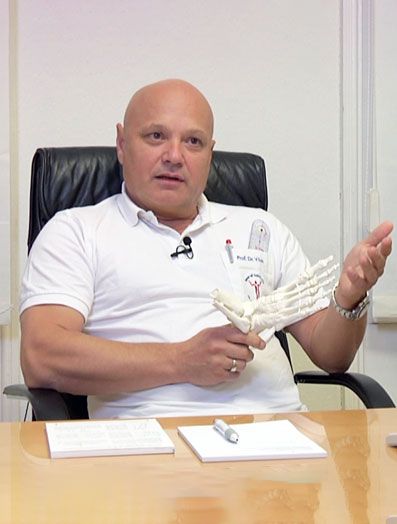Lower ankle
The lower ankle is a key joint of the foot.
This joint connects the ankle bone (talus) to the heel bone (calcaneus). It consists of 2 sections of the joint, divided by the sinus tarsi. It is regarded as a foot control, as the damping mechanism of the foot is locked and unlocked by the lower ankle. So this is where it is determined whether the forces are absorbed well on impact of the foot on the ground, or if they are delivered onto the foot and ultimately to the rest of the body undamped- and whether the structures that were not designed therefore – are harmed with every step.
Conversely, the lower ankle also controls the locking of the foot during a push-off. If this does not work, then the unlocked, i.e. flaccid foot is damaged by the constant repulsive forces and an early arthritis is the result.
Remedy
Functional support inserts that improve the function of the lower ankle and help control the foot.
Is the lower ankle already infested by osteoarthritis (joint abrasion) and destroyed, then the remedy is often only the stiffening of that joint after an unsuccessful conservative treatment. After that, the foot may indeed have various shortcomings, such as a poor walking on uneven ground, but these patients are often plagued by so much pain that this surgery significantly enhances their quality of life, as they can finally walk without pain.
Examples:
Case I
Links: In the MRI severe cartilage damage is seen and an osteoarthritis indication in the lower ankle (arrows).
Right: After fusion and screwing the lower ankle, and the patient walks well and free of pain.
Case II
This patient is suffering from severe instability of the entire hindfoot.
After a heavy injury the bones healed, but the ligaments did not. The upper and lower ankle are destroyed. She has been using a walker for months and relieving the leg completely, as it can not carry her. This has resulted in a massive osteoporosis (bone softening).
Both the upper ankle (upper arrows) and the lower ankle (lower arrows) are destroyed and without cartilage. Moreover, the bone is literally as soft as fresh bread due to the osteoporosis.
After a fusion with the so-called arthrodesis nail.
Cartilage was removed from both ankles (the remains of the destroyed cartilage) and the vital bone is shown. The arthrodesis nail is then inserted from the heel bone until the shin bone and secured with diagonal screws.
The lower part of the fibula is removed beforehand so that it does not block the way. Despite the enormous stability of the nail, the patient has to be immobilized for 6 weeks with a leg cast.
Then begins the period of relearning how to walk, because the patient could not walk for many months before. This phase was completed in 3 months and the lady walks pain free now and very satisfyingly.



